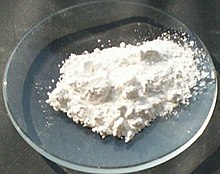
Back Gebluste kalk Afrikaans هيدروكسيد الكالسيوم Arabic Kalsium hidroksid Azerbaijani کلسیوم هیدروکسید AZB Калциев хидроксид Bulgarian ক্যালসিয়াম হাইড্রোক্সাইড Bengali/Bangla Kalcij-hidroksid BS Hidròxid de calci Catalan Hydroxid vápenatý Czech Кальций гидроксичĕ CV

| |

| |
| Names | |
|---|---|
| IUPAC name
Calcium hydroxide
| |
Other names
| |
| Identifiers | |
3D model (JSmol)
|
|
| ChEBI | |
| ChemSpider | |
| ECHA InfoCard | 100.013.762 |
| EC Number |
|
| E number | E526 (acidity regulators, ...) |
| 846915 | |
| KEGG | |
PubChem CID
|
|
| RTECS number |
|
| UNII | |
CompTox Dashboard (EPA)
|
|
| |
| |
| Properties | |
| Ca(OH)2 | |
| Molar mass | 74.093 g/mol |
| Appearance | White powder |
| Odor | Odorless |
| Density | 2.211 g/cm3, solid |
| Melting point | 580 °C (1,076 °F; 853 K) (loses water, decomposes) |
| |
Solubility product (Ksp)
|
5.02×10−6 [1] |
| Solubility |
|
| Acidity (pKa) | pKa1 = 12.63 pKa2 = 11.57[2][3] |
| −22.0·10−6 cm3/mol | |
Refractive index (nD)
|
1.574 |
| Structure | |
| Hexagonal, hP3[4] | |
| P3m1 No. 164 | |
a = 0.35853 nm, c = 0.4895 nm
| |
| Thermochemistry | |
Std molar
entropy (S⦵298) |
83 J·mol−1·K−1[5] |
Std enthalpy of
formation (ΔfH⦵298) |
−987 kJ·mol−1[5] |
| Hazards | |
| GHS labelling: | |
 
| |
| Danger | |
| H314, H335, H402 | |
| P261, P280, P305+P351+P338 | |
| NFPA 704 (fire diamond) | |
| Flash point | Non-flammable |
| Lethal dose or concentration (LD, LC): | |
LD50 (median dose)
|
7340 mg/kg (oral, rat) 7300 mg/kg (mouse) |
| NIOSH (US health exposure limits): | |
PEL (Permissible)
|
TWA 15 mg/m3 (total) 5 mg/m3 (resp.)[7] |
REL (Recommended)
|
TWA 5 mg/m3[7] |
IDLH (Immediate danger)
|
N.D.[7] |
| Safety data sheet (SDS) | [6] |
| Related compounds | |
Other cations
|
Magnesium hydroxide Strontium hydroxide Barium hydroxide |
Related bases
|
Calcium oxide |
| Supplementary data page | |
| Calcium hydroxide (data page) | |
Except where otherwise noted, data are given for materials in their standard state (at 25 °C [77 °F], 100 kPa).
| |
Calcium hydroxide (traditionally called slaked lime) is an inorganic compound with the chemical formula Ca(OH)2. It is a colorless crystal or white powder and is produced when quicklime (calcium oxide) is mixed with water. It has many names including hydrated lime, caustic lime, builders' lime, slaked lime, cal, and pickling lime. Calcium hydroxide is used in many applications, including food preparation, where it has been identified as E number E526. Limewater, also called milk of lime, is the common name for a saturated solution of calcium hydroxide.
- ^ John Rumble (18 June 2018). CRC Handbook of Chemistry and Physics (99 ed.). CRC Press. pp. 5–188. ISBN 978-1138561632.
- ^ "Sortierte Liste: pKb-Werte, nach Ordnungszahl sortiert. – Das Periodensystem online".
- ^ ChemBuddy dissociation constants pKa and pKb
- ^ Petch, H. E. (1961). "The hydrogen positions in portlandite, Ca(OH)2, as indicated by the electron distribution". Acta Crystallographica. 14 (9): 950–957. doi:10.1107/S0365110X61002771.
- ^ a b Zumdahl, Steven S. (2009). Chemical Principles 6th Ed. Houghton Mifflin Company. p. A21. ISBN 978-0-618-94690-7.
- ^ "MSDS Calcium hydroxide" (PDF). Archived from the original (PDF) on 25 March 2012. Retrieved 21 June 2011.
- ^ a b c NIOSH Pocket Guide to Chemical Hazards. "#0092". National Institute for Occupational Safety and Health (NIOSH).
© MMXXIII Rich X Search. We shall prevail. All rights reserved. Rich X Search
